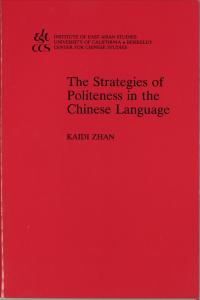The Strategies of Politeness in the Chinese Language
The Strategies of Politeness in the Chinese Language
Kaidi Zhan
This monograph describes and demonstrates the politeness strategies used by speakers of Mandarin Chinese and explains these strategies to readers whose native language is English. As a contrastive study, it explores what aspects of behavior are universal, what aspects specific to a group. As a theoretical exploration, the work is of value to scholars in pragmatics, sociolinguistics, sociology, psychology, and anthropology.
As a nonprofit academic press, we need your support to publish our books. Your gift can help us make more of our titles available as e-books. DONATE NOW
Title information
This monograph describes and demonstrates the politeness strategies used by speakers of Mandarin Chinese and explains these strategies to readers whose native language is English. As a contrastive study, it explores what aspects of behavior are universal, what aspects specific to a group. As a theoretical exploration, the work is of value to scholars in pragmatics, sociolinguistics, sociology, psychology, and anthropology; it also has practical value for teachers and learners of language. Examples are taken from recorded dialogues, contemporary literature, and the Dream of the Red Chamber (18th century).
The Strategies of Politeness in the Chinese Language (Special Publication)
Preface—vii
Acknowledgements—xv
1. Introduction—1
2. Positive Politeness—13
3. Negative Politeness—41
4. Off Record—69
Conclusion—99
Works from Which Examples Were Extracted—101
References—103
|
JOURNAL REVIEWS |
|
"[T]his is the first systematic monograph about politeness in Chinese, written with a native speaker's insights and intuitions. The author provides some genuine nuggets to ponder, and some tantalizing glimpses into the linguistic origins of enduring cultural distortions and stereotypes." ~Linda Young, in China Review International (http://www.jstor.org/stable/23728710) |

